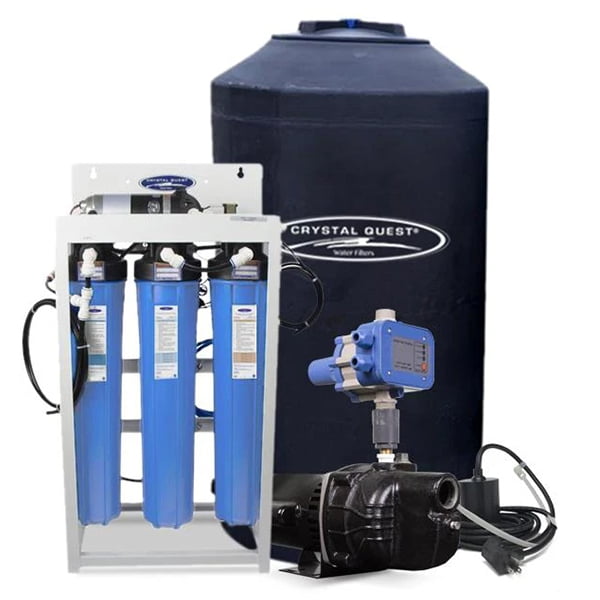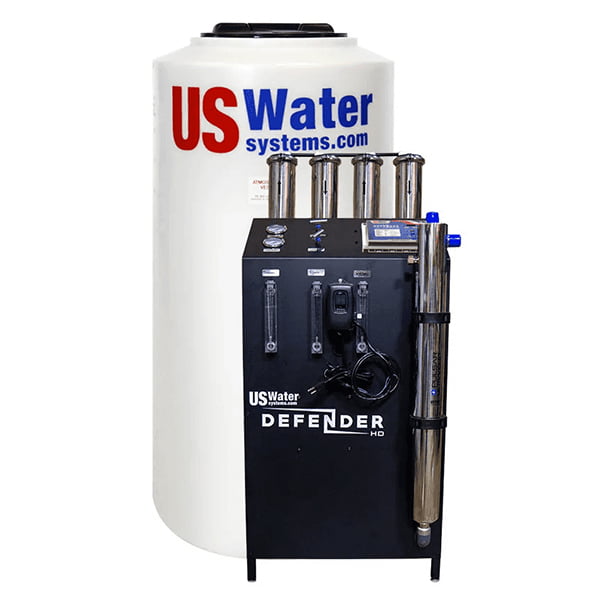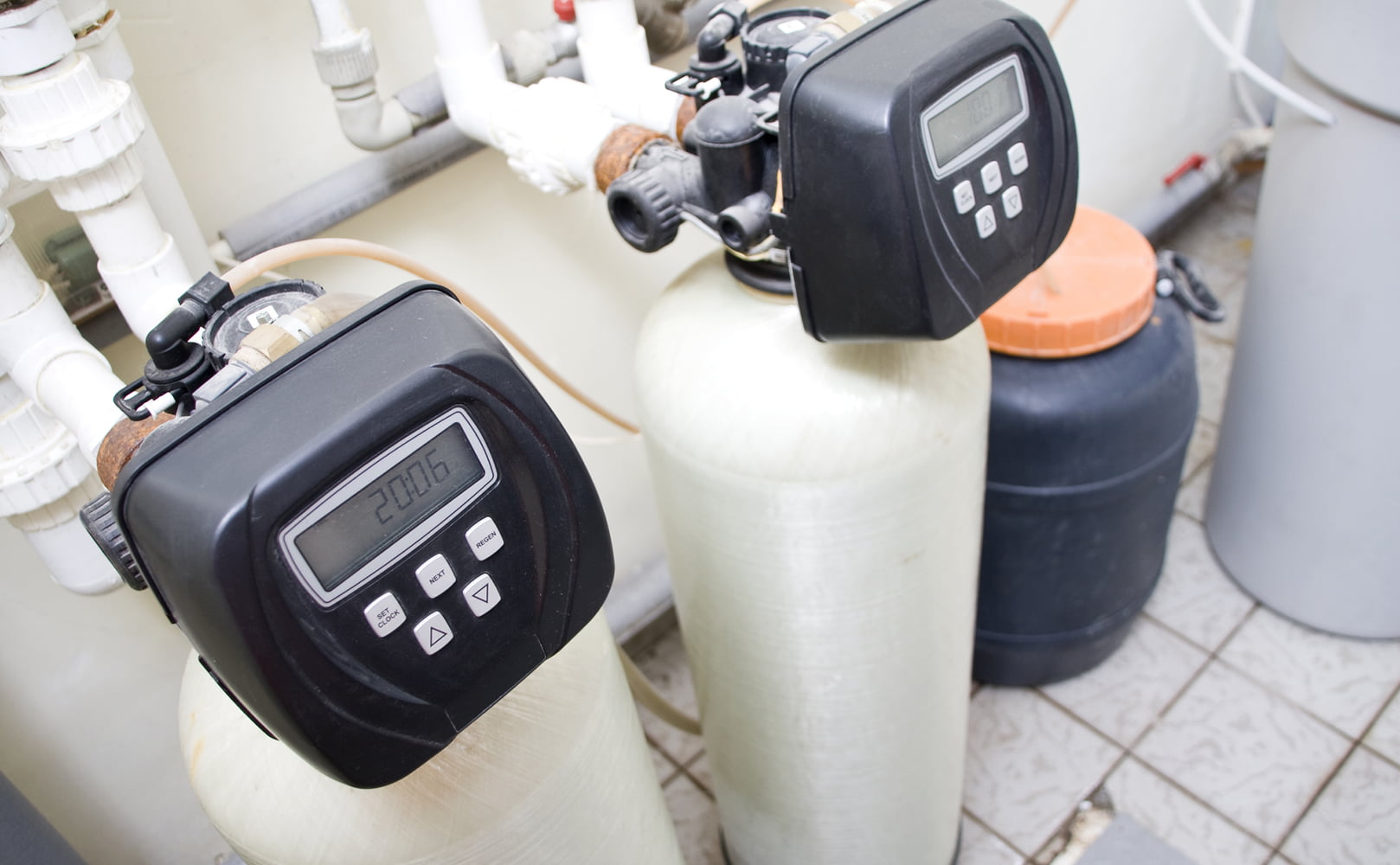How Much Does a Whole House Reverse Osmosis System Cost?
Written by: Gene Fitzgerald // Last Updated: Aug 25, 2023
This page may contain affiliate links. If you buy a product or service through such a link we earn a commission at no extra cost to you. Learn more.
Whole house reverse osmosis systems are complex water purifiers installed at the water’s point of entry to your entire home. These systems are significantly more complex than under sink RO units, so it’s no surprise they cost more than their point-of-use counterparts.
The main advantage of whole house RO systems is that, unlike under sink models, they’ll provide clean filtered water to every faucet, shower, and appliance in your home. If your water is supplied by a well or is of questionable quality, then whole house reverse osmosis can be well worth the cost.
Still, let’s take a look at the cost of purchasing a whole house RO system, the major factors influencing this cost, as well as installation and ongoing maintenance and operating expenses.
Key Takeaways
- Whole house reverse osmosis systems are complex. They filter the entire water supply to your home. Because they must filter significantly more feed water than point of use systems, they are much larger and also cost much more.
- The exact cost of a whole house reverse osmosis system varies mainly based on its capacity (size), additional pre and post-treatment, storage tank size, and extra features like wastewater recycling.
- The bare minimum is $1,500 for a whole house RO system including storage tank and delivery pump, although a typical setup costs $3,000 and upwards. Around $10,000 is quite common for larger homes including pre and post-filters.
- In addition to the cost of the system itself, you’ll need to consider the cost of installation, maintenance, and operation.
Whole House Reverse Osmosis System Prices 2023
So, how much does a whole house reverse osmosis system cost? Well, anywhere between $500 and $10,000+.
The below chart shows up-to-date prices of real-life whole house reverse osmosis system that you can buy online:
| Whole House Reverse Osmosis System | Price Tag |
|---|---|
| Crystal Quest Whole House Reverse Osmosis System – 1000 GPD with Storage Tank Kit and Remineralization | $6,643.20 |
| Crystal Quest Whole House Reverse Osmosis System – 500 GPD Standalone | $2,883.65 |
| USWS Defender Whole House RO System – 2000 GPD with 250-Gallon Atmospheric Storage Tank | $8,466.95 |
| USWS Defender Whole House RO System – 2000 GPD with 250-Gallon Atmospheric Storage Tank and Carbon Pre-Filtration | $9,215.95 |
| iSpring RCB3P Reverse Osmosis Water Filtration System – 300 GPD, Tankless | $544.17 |
| Reverse Osmosis Superstore Light Whole House Reverse Osmosis System – 1000 GPD with 300-Gallon Water Tank, Delivery Pump, Acid Neutralizer, and UV Disinfection | $7,200.00 |
| RainDance-1200 Whole House Reverse Osmosis Package – 1200 GPD with 300-Gallon Tank | $7,183.00 |
*Last Updated: January 2023
How Much Does a Whole House Reverse Osmosis System Cost?
Whole house reverse osmosis systems are inherently complex, so you can’t expect to purchase one for the cost of an under sink filter. That said, there is a large variation within the cost of these systems, and you can still purchase a basic unit for a reasonable price.
Residential Whole House RO Cost
A residential whole house RO system starts at about $500 – for a basic unit mind you. That’s about as cheap as you can go, and doesn’t include a storage tank or delivery pump. When you add in these components, you’re looking at about $1,500 at the low end.
Typical residential whole house reverse osmosis systems cost $3,000 and up, with $10,000+ systems being common for larger applications.
We Recommend: Crystal Quest Thunder
Our Runner-Up: USWS Defender
Commercial Reverse Osmosis System Cost
Commercial whole house reverse osmosis systems are popular in a wide range of businesses including coffee shops, restaurants, breweries, car washes, and hotels. As you might expect, the cost of a commercial RO system also depends on its size and filtration capacity. Expect $500 to be the absolute minimum.
Smaller commercial systems, as you might find in a coffee shop, will cost similar to residential systems. Larger units with high capacities can easily run into the tens of thousands, so a precise estimate is hard to make.
Industrial Applications
Reverse osmosis systems for industrial usage are the highest capacity and most expensive systems out there. Hence they cost significantly more than residential or commercial setups.
How much more? A precise cost estimate isn’t possible without getting into specifics, but on the low end, these systems cost tens of thousands. If you’re looking at units with higher flow rates, then $100,000+ is quite common.
Factors Affecting Whole House Reverse Osmosis System Costs
Below are the factors affecting whole house reverse osmosis system cost.
Size
The primary factor influencing a system’s cost will be its size. Size in this case is determined by the system’s daily filtration capacity.
The capacity will be rated in gallons per day (GPD), which is the number of gallons of filtered water the system can produce each day. It’s important to keep in mind that the GPD rating will differ from real life performance, as the GPD number is calculated based on ideal conditions.
Besides, a whole house reverse osmosis system shouldn’t run at full capacity all the time. 75% or less is considered ideal.
To calculate your requirements, you can assume 80 to 100 gallons of water use per day for each person in your household. So, for a family of four, you would need a system with at least 400 gallons per day capacity. If we conservatively assume we aim for 50% utilization of the stated GPD, then you’ll need a system with 800 GPD daily filtering capacity.
While almost all whole house RO systems utilize a storage tank to keep enough filtered water on hand to fulfill your requirements, the system’s flow rate should be considered if you’re planning to go tankless. This is measured in gallons per minute (gpm) instead of GPD.
Tank or No Tank
When it comes to residential whole house RO systems, you’ll need a storage tank to keep enough water available for immediate use. Only commercial systems are sometimes tankless.
Most systems utilize an atmospheric tank, which is a non-pressurized tank. This means the water must be re-pressurized for it to flow through your plumbing. This requires the use of one or more pressure pumps which adds to the cost.
There are also RO systems with pressurized bladder tanks which don’t require the use of a pump to operate.
As far as tank size is concerned, it should be able to hold the amount of water that you use over the course of one day at minimum!
Pre and Post-Treatment
Both pre and post-treatment is necessary for any POE RO system to function properly. Without them, the RO membrane would fail prematurely leading to a costly repair. And your plumbing system would most likely suffer from corrosion.
Pre-filters remove contaminants before they can reach and damage the RO membrane, while post-filters are used to increase pH (and improve the water’s taste).
Whole house RO systems typically use a sediment pre-filter to remove coarse dirt, a carbon pre-filter to remove chlorine/chloramine, a water softener to reduce water hardness, and possibly additional filtration to remove iron, manganese, sulfur, etc.
Post-filters are used to raise the water’s pH so it won’t damage pipes and fixtures. A carbon post-filter is sometimes used to “polish” and improve the water’s taste. Some systems also include a UV light. It eradicates any microbial contamination with nearly 100% effectiveness.
These additional treatment stages could easily add a couple of thousand dollars to the overall cost of your whole house RO filter.
NSF Certification
NSF certification refers to water filter systems and their components that have been independently evaluated against NSF standards (the NSF is a third-party organization that establishes standards and reviews the claims manufacturers make about their products).
Parts certified by the NSF may cost slightly more than uncertified parts, but you can be confident they will do what they are advertised to do.
Additional Features
Whole house RO systems are highly customizable, so there is no shortage of add-ons and upgrades you can include should you wish.
- Flow meters are used to measure the actual water flow rate through the system.
- Pressure gauges will give you a precise reading of the water pressure in psi at a specific point in your system.
- Wastewater recycling is another optional feature.
Your system may come with these included, but if not and you want any of them, it’ll increase the price.
The Brand
Unsurprisingly, systems from well-known established brands will cost you more than those from unknown brands. That doesn’t mean you should disregard a cheaper system just because it’s from a lesser-known brand, but make sure to do your research before making such a significant purchase.
System Installation Cost
Whole house RO systems are fairly complex systems, so the installation process is more involved than installing a basic under sink water filter.
DIY Installation vs. Hiring a Pro
Completing a DIY installation of a whole house RO system is possible, but really should only be attempted if you have some DIY experience and plumbing knowledge. The process will take several hours (not including soaking and rinsing the storage tank).
Alternatively, if you don’t feel comfortable installing the system yourself, you can always hire a plumber or contractor to do it for you. The cost for this will vary but will probably average about $100 per hour.
Maintenance and Operating Costs
When considering an RO system’s cost, you also need to factor in the costs of ongoing maintenance and operation. Let’s take a look at these briefly.
Filter & Membrane Replacements
Pre-filters generally need to be replaced every 6 to 12 months, while the RO membrane will last up to 3 and 5 years before it needs to be replaced.
The exact costs will vary depending on your specific system and the number of pre-filters. In general, pre-filters will cost between $150 and $200 yearly, while the RO membrane will cost between $150 and $300 on average.
If we average the cost of the membrane over its lifespan to $75 per year, then you’re looking at between $225 and $275 yearly for both the filters and the membrane.
Wastewater
As mentioned previously, RO generates wastewater as part of the filtration process. This is unavoidable, although it can be reduced significantly by using booster pumps and wastewater recycling.
If we go with the USGS estimate and assume that each member of a family of four consumes 80 gallons of water per day, then we’ll need 320 gallons of filtered water per day from the system. Let’s assume the RO system has a 50% recovery rate (the ratio of feed water to filtered water), then we will be consuming 640 gallons of feed water daily.
Tap water only costs about $0.002 per gallon on average in the US, so our daily water cost will be $1.28. This translates to $467 per year.
Of course, if your water is sourced from a well, then your water costs will be zero.
Electricity
Electricity costs tend to vary significantly by region, so it’s difficult to make a precise calculation here. The most significant cost here will be from the water pump(s), which will add to your electricity bill a bit.
If you have any questions about whole house RO system cost please don’t hesitate to leave a comment below!
Information provided on BOS is for educational purposes only. The products and services we review may not be right for your individual circumstances.
We adhere to strict editorial guidelines. Rest assured, the opinions expressed have not been provided, reviewed, or otherwise endorsed by our partners – they are unbiased, independent, and the author’s alone. Our licensed experts fact-check all content for accuracy. It is accurate as of the date posted and to the best of our knowledge.




